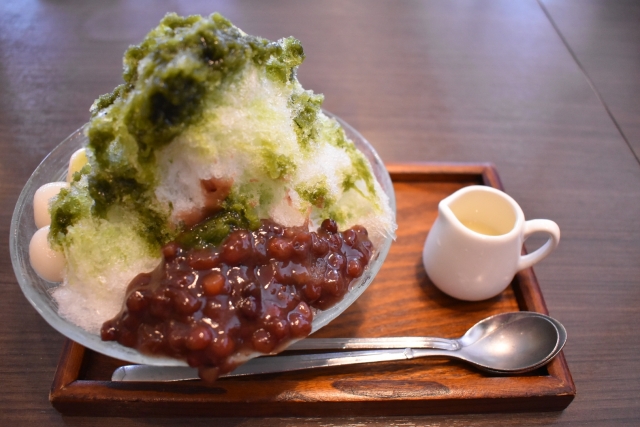 Of all the dishes one could eat in the unbearable Japanese summer, kakigori is the most refreshing. No wonder, since it is nothing else than shaved ice with added flavour. During summer, it’s sold pretty much everywhere, from simple street stalls at festivals to convenience stores or traditional kissaten cafes and there are even shops that specialise in kakigori. To advertise kakigori, a special banner is used, showing the kanji for “ice”.
Of all the dishes one could eat in the unbearable Japanese summer, kakigori is the most refreshing. No wonder, since it is nothing else than shaved ice with added flavour. During summer, it’s sold pretty much everywhere, from simple street stalls at festivals to convenience stores or traditional kissaten cafes and there are even shops that specialise in kakigori. To advertise kakigori, a special banner is used, showing the kanji for “ice”. While having ice available in summer only became widespread from the 19th century onwards, the nobility could enjoy kakigori as early as the Heian period of the 11th century. It is already mentioned in Sei Shonagon’s Pillow Book, when it was a rare treat even at court. At that time, large blocks of ice were cut from rivers during the winter and then stored in mountain caves or special ice houses that would reach deep into the earth.
While having ice available in summer only became widespread from the 19th century onwards, the nobility could enjoy kakigori as early as the Heian period of the 11th century. It is already mentioned in Sei Shonagon’s Pillow Book, when it was a rare treat even at court. At that time, large blocks of ice were cut from rivers during the winter and then stored in mountain caves or special ice houses that would reach deep into the earth.
Nowadays, the ice for kakigori is mineral water frozen into blocks. Great care is taken that the ice turns into a fluffy, snow-like consistency when shaved, and it is this consistency that sets kakigori apart from other shaved ice desserts like snow cones. These days, electric machines are used to shave the ice, but there are still street vendors who use a traditional hand-cranked machine. These machines are ubiquitous at flea markets; they come in all sizes and very small ones are still occasionally sold at household goods stores. Once the ice is properly shaved, it is put on a dish – special korikoppu dishes were popular before WWII – and then it’s time for the flavouring. Heavy syrup that comes in numerous flavours is poured over the ice, and you can have your kakigori as strawberry, lemon, plum, grape, matcha… An extra dash of condensed milk adds a bit of sweetness.
Once the ice is properly shaved, it is put on a dish – special korikoppu dishes were popular before WWII – and then it’s time for the flavouring. Heavy syrup that comes in numerous flavours is poured over the ice, and you can have your kakigori as strawberry, lemon, plum, grape, matcha… An extra dash of condensed milk adds a bit of sweetness. While the basic kakigori is available throughout Japan, there are a few local varieties as well. Shirokuma (literally polar bear) comes with small mochi, condensed milk, anko, and a variety of fruits added to the shaved ice. This type of kakigori was invented in Kagoshima during the Edo period and is now known throughout Japan.
While the basic kakigori is available throughout Japan, there are a few local varieties as well. Shirokuma (literally polar bear) comes with small mochi, condensed milk, anko, and a variety of fruits added to the shaved ice. This type of kakigori was invented in Kagoshima during the Edo period and is now known throughout Japan.
Another version is Ujikintoki with green tea syrup and anko. It is named after Uji, a small town near Kyoto that is famous for its green tea and kintoki, a type of red bean paste. Whether you get a small cup of eat-as-you-go kakigori at a festival or sit down at a specialty shop for a large bowl topped with fruit, kakigori is always a welcome refreshment in the hot Japanese summers and worth trying all the flavours.
Whether you get a small cup of eat-as-you-go kakigori at a festival or sit down at a specialty shop for a large bowl topped with fruit, kakigori is always a welcome refreshment in the hot Japanese summers and worth trying all the flavours.
